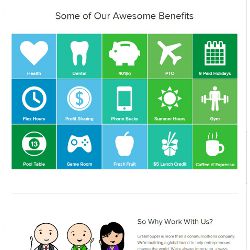
Human resources consulting firm Robert Half Technology recently released its 2014 Salary Guide for Technology Professionals, which contains ample good news for tech workers. Average salaries, already substantial, are up across the board with annual increases ranging between 2.5 and 7.8 percent. Security officers, applications architects, and mobile app developers are making well over six figures, with salary bumps from last year of 5.9 percent, 6.8 percent, and 7.8 percent, respectively.
But salary increases aren’t the only good news for technology workers. To attract and retain top talent, employers are offering a wide range of perks — extras thrown in on top of the salary, stock options, performance incentives, health care, and more that go into a standard benefits package. According to the report, many companies even tout their perks on the recruiting parts of their website. The report calls out seven perks as examples of what’s on offer: nutritious free food, professional development reimbursement, environmental responsibility (one company offers workers with one year of full-time employment $10,000 toward the purchase of a hybrid vehicle), generous family leave, on-site health and fitness services, house cleaning, and vacation subsidies.
Why do employers offer so many perks, and how do employees feel about them?
The Value for Employees
Shravan Goli, president of Dice.com, a leading job board for tech workers, asked his engineering staff how they felt about his company’s perks, and the response was overwhelmingly positive. But it went beyond just the attraction of free stuff — the perks go a long way toward supporting the tech worker lifestyle. "They arrive late and they stay late," he says. "They don’t want to be distracted by the question of ‘How do I get my lunch, or do I have to make it at home?’ They love the food because it saves them time." With the food right there in the office, they can eat whenever they want. If they’re in the flow of a job and just want to get it done, they can just keep working.
However, they also sometimes need a break from the intensity of their work. "My last company used to offer monthly on-site chair massages," Goli recalls. "When I polled the team a few months after I introduced them, they said that if you have to take away anything, don’t take away the massages. Other perks I’ve seen include fitness rooms in the building. They don’t take you away from the building, but it still gives the employees the chance to go without having to drive somewhere."
Besides, Goli says, "in this day and age, your work is in your pocket. You work from home a lot more as well — telecommuting is a perk that’s pretty much understood for most technology companies. So the differentiation between whether work is getting done at home or work is getting done in the office is definitely blurred. As long as it’s convenient to work wherever you are, that differentiation sort of goes away." For employees who are working some of the time at home and some at the office, "if you make the office a lot more homelike, you see happier employees overall."
The Value for Employers
Similarly, from the employer’s point of view, perks aren’t just about keeping workers happy with freebies — they’re part of creating a positive employer brand. According to Jon M. Davis, executive vice president of IT staffing company Matrix, tech workers look for two things in a prospective job: whether they’ll be working on the latest technology, in order to keep their skills sharp and themselves marketable, and the company culture. "What I find is that employers who do a good job of attracting the best and the brightest focus on building culture," he says. "People want to feel like their contributions are valued," and part of it are these "feel-good things."
What those might be vary from company to company and reflect the employer’s values. "I’m not sure every perk has the same value," says Goli. "When I visit a lot of companies, they’ve rated massages and free food as the top perks and didn’t care about not having a ping pong table and those kinds of things. In other companies, it might be different."
"We have a client in Houston," Davis recalls, "where on Fridays they cater in a lunch and show movies." But, he stresses, the movies aren’t the point: the point is the shared community event and how that demonstrates the company culture.
Potential Drawbacks
Free food, massages, ping-pong tables — who could object to a workplace like that? According to Davis, it depends on the employer’s intent. "If there’s a stated or implied expectation that the employee will be there all the time, it changes the perception." He recalls one client who built a "compound" that offered every service one could want on site, but nevertheless came to have the reputation of being a sweatshop. "Another, MCI, used to have catered lunches, late afternoon snacks, early dinners, that kind of thing. But they were trying to squeeze 10-hour days out of their employees, and eventually employees started to perceive that the employer was trying to take advantage of them."
There’s also some question of whether the appeal of these kinds of perks might be limited by the age of the employees at the companies that offer them. An article on ageism in Silicon Valley quoted Facebook’s Mark Zuckerberg as saying to a startup event at Stanford University in 2007, "I want to stress the importance of being young and technical. . . Young people just have simpler lives. We may not own a car. We may not have family. Simplicity in life allows you to focus on what’s important."
As workers get older, of course, their idea of what’s important in life evolves. "A lot of younger technology professionals don’t necessarily have to go home to attend to something else," says Dice.com’s Goli. "In that context, having food and these kinds of services taken care of for them is much more useful." But when soccer practices and school functions start to come on the scene, hours get more regular, and being able to eat at your desk at 8PM becomes less of an attraction.
The bottom line is that perks are still just that — extras. They can’t make up for a bad working environment. "If a company’s counting on perks to replace culture, it won’t work," says Davis. "Perks are the icing on the cake. They’re not the cake."



Join the Discussion (0)
Become a Member or Sign In to Post a Comment